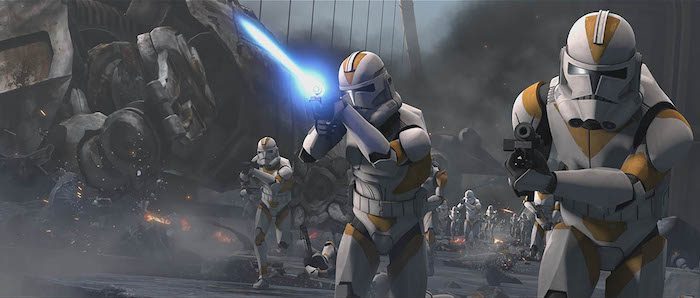‘Star Wars: The Clone Wars’ Finally Reaches the Siege of Mandalore With “Old Friends Not Forgotten”

After a six-year hiatus, Star Wars: The Clone Wars zeroes in on its forestalled conclusion with both anticipation and dread considering the tragedy that befalls the Prequel Trilogy. However, every moment counts to spend time with the characters that have endeared us over seven seasons. With a quick-to-the-punch direction by Saul Ruiz, “Old Friends Not Forgotten” kicks off Part 1 of the long-awaited Siege of Mandalore arc that intermingles with the Revenge of the Sith timeline.
A gratifying four-minutes longer than the traditional 22-minute-length, the episode opens with a bang. It begins with Kevin Kiner’s Ahsoka Tano theme before it strikes with the John Williams fanfare. When The Clone Wars title pops up and recedes into the stars like the titles of the Star Wars movies, you almost expect the gold crawl text. That is, until it cuts into the montage with by Tom Kane’s narration and you’re reminded you’re viewing another dimension and design of Star Wars that wasn’t present in the movies.
The stakes are high. Anakin Skywalker (Matt Lanter) and Obi-Wan Kenobi (James Arnold Taylor) are fresh out of a Republic victory against the Separatists in the Outer Rim. They are surprised by a transmission from Ahsoka Tano (Ashley Eckstein) and Bo-Katan Kryze (Katee Sackhoff), the leader of the Mandalorian Nite Owls, who seek a Republic alliance to cleanse Mandalore of Maul’s (Sam Witwer) influence.
I derive contradictory euphoria when observing the two obvious throwbacks to the pilot. Anakin executes a surrender ruse to the Separatist droids, not unlike Obi-Wan Kenobi’s ploy in the pilot. Secondly, Ahsoka descends the ramp to Skywalker and Kenobi, this time in new garb (and a non-revealing outfit, ahem, George Lucas). Those homages to its low-grade pilot reminded me of its less-than-well-rendered launch and how its accumulating quality and eventual polish ultimately paid off.
The polish in design and story has been palpable since the Bad Batch arc, and the bump-up in scope, action, and character consciousness is something to behold. With showrunner Dave Filoni as the scriptwriter, every character is written with care under as their emotions brew beneath high-pressure bureaucratic obligations. When Ahsoka first greets Anakin, she’s chilly, but their time together warms up their old fondness for each other. Anakin rationalizes Ahsoka’s departure from the Order on his own egoistical terms, as a purpose of the Force and a means for Maul’s capture, not because Ahsoka acted out of agency. Kenobi is not uninvested, but keeps a rather remote cautious optimism, compared to Ahsoka’s more open investment when she grabs her chance to express her resentment against the Jedi Order’s loyalty to politics over people—“I’m not trying [to be fair].” Living among neglected underworld civilians like the Martezes has made her wearier about the Order’s flaws.
Bo-Katan also emerges with fascinating contradictions and injects a dose of moral ambiguity. Ally as she may be to the Republic and Ahsoka to liberate Mandalore, the direction wisely doesn’t frame her as a hero or savior. She may be a device for Mandalore’s liberation, but her goals and temper retain their dubious edges. “What’s one more [war]?” is cuttingly delivered by Sackoff that carries the weight of the damned-if-we-do-damned-if-we-don’t dilemma that could involve breaching treaties or condoning a threat. It remains to be seen how she felt about a sister she both loved and opposed ideologically while having anger toward the murder of “their ruler,” suggesting she’s disgruntled beyond not only familial grief but fidelity to Mandalore.
You may notice that I’ve spent more time ruminating on the character idiosyncrasies than the stormy skirmish on Mandalore. A great giddiness never left me hearing these characters strategize, quip, and bare their hellos and farewells—for Anakin, Rebels fans know this will be his final goodbye to Ahsoka before his fall. As Ahsoka comes face-to-face with Maul, the episode gives me a great deal of faith that it will have emotional surprises, even if we know how it all ends for Anakin and Ahsoka.
Tidbits
- I didn’t talk about it in my last review since I was waiting for The Clone Wars to give its own in-universe explanation for Maul’s regaining his presence on Mandalore, despite being last seen overpowered by Darth Sidious in the series. Those who read the 2014 “Son of Dathomir” comics, which adapted a canceled Clone Wars storyline, will know how Maul escaped Darth Sidious’s clutches and saw the death of Mother Talzin. There is a certain disadvantage to having other medium tie-ins wrapped up storylines for the TV series. For example, Clone Wars viewers may get the impression that Talzin (and the likes of Asajj Ventress who died in a canonical novel Dark Disciple) is still out there somewhere. Unless it’s covered later in Clone Wars, Maul’s reestablished control of Mandalore can feel out of left field.
- I spy, Depa Billaba and her apprentice Caleb Dume, the latter who will later become Kanan Jarrus of Star Wars Rebels.
- Kenobi also addresses losing Duchess Satine Kryze, an interesting character who was killed off for Kenobi’s manpain which undercut a potentially thematic end for the character herself
- When Mace Windu referenced Shaak Ti’s failure to secure the Chancellor, I think of Shaak Ti of Genndy Tartakovsky’s 2003 proto-canon Clone Wars more than the Revenge of the Sith deleted scene.
- Interesting that Ursa Wren (Sharmila Devar) is not addressed by her Mandalorian Countess honorifics and Bo-Katan and Ahsoka call her by her first name. Rook Kast (Vanessa Marshall) is also addressed by her first name, while Saxon (Ray Stevenson) is addressed by his surname.
The post ‘Star Wars: The Clone Wars’ Finally Reaches the Siege of Mandalore With “Old Friends Not Forgotten” appeared first on /Film.
from /Film https://ift.tt/3es4ScB
No comments: